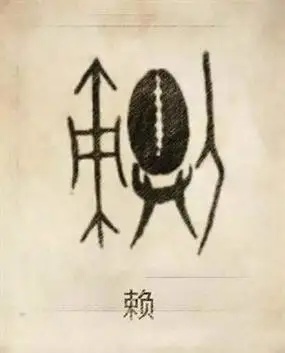The Lai(lài) surname is one of the oldest surnames in China, with origins tracing back to the Zhou Dynasty and the Yandi tribe, embodying early political enfeoffment and ethnic blending of Chinese civilization.

Ⅰ、Origin of the Surname:
1. Ji surname Lai State: A branch of the Zhou royal family
After King Wu of Zhou destroyed the Shang Dynasty, he enfeoffed his younger brotherubing in Lai State (present-day Xixian County, Henan), establishing a vassal state with the rank of Marquis. Lai State was later annihilated by King Zhuang of Chu in the Spring and Autumn Period, and its survivors took the name of the state as their surname, the main line of the Lai surname, historically known as the "Direct Line of the Lai Family".
2. Jiang surname Lai State: The southward migration of Yandi's descendants
Another branch of the Lai surname originated from the descendants of Emperor Shennong of theandi tribe, the Leishan family (also known as the Lai Shan family). During the Shang Dynasty, the Leishan family migrated east to establish Lai State in Lishi, Henan. It was annihilated by the State of Chu in the Spring and Autumn Period, and its descendants took the of the state as their surname, becoming another important source of the Lai surname.
3. Ethnic Integration and Cultural Symbiosis
The Achang people's "Lalai" clan changed their surname to Lai. During the Ming and Qing dynasties, someai surnamed people in Sichuan and Yunnan integrated into the Achang ethnic group; after migrating to Taiwan, the Lai surnamed people Fujian and Guangdong intermingled with the local ethnic groups, forming a unique cultural bond.
Ⅱ、 Historical Figures
1. Statesmen and Scholars
Lai Fu: At the age of seven, he could write, and by twenty, he was familiar with a hundred schools of. After passing the imperial examination, he refused the official position and retired to the mountains, where his residence was praised as the "Secretary's Alley" becoming the source of the Lai family's "Secretary's Hall" hall number.
Lai Wenjun: A grandmaster of geom, known as "Lai the Robe", whose works have influenced East Asian architectural culture to this day.
2. Military Leaders and the Spirit of
Lai Han'ying: A famous general of the Taiping Heavenly Kingdom, he led the army to fight in the Yangtze River Basin became a symbol of the anti-Qing movement.
Lai Chuanzhu: An inaugural general of the People's Liberation Army, he participated the Long March and the War of Resistance Against Japan, and was a model of military and political work.
3. The Light of Art and Technology
ai Jing: A master of poetry, calligraphy, and painting, known as the "Triple Excellence", whose works blend the elegance of liter with folk wisdom.
Lai Zuwu: A nuclear physicist, he presided over the construction of China's first fast neutron reactor, promoting development of nuclear energy technology.
Ⅲ、Cultural Significance:
1. Prefecture Fame and Migration History
Five major prefure reputations: Yingchuan (Henan), Nankang (Jiangxi), Songyang (Zhejiang), Henan, Henei, marking the migration trajectory of the Lai surname from the Central Plains to the south of the Yangtze River.
2. Hall and Ancestral Hall Culture
Secretary's Hall: Commemorating the academic spirit of Lai Fu in the Tang Dynasty, symbolizing Lai family's emphasis on education and knowledge.
Yingchuan Hall: Tracing back to the origins of the Zhou Dynasty Lai, reinforcing the consciousness of the clan's roots. Many Lai ancestral halls have been preserved in Guangdong, Fujian, and other places, as the "Ximmei Hall" in Meizhou and the "Lai Family Temple" in Taipei, becoming spiritual landmarks that unite the clans.
Ⅳ、Social Impact: From Population Migration to Modern Contributions
1. Population Distribution
The current population of the Lai s is about 2.4 million, mainly concentrated in Guangdong, Fujian, Jiangxi, and Taiwan, forming a "Guangdong-Jxi-Fujian" core distribution area.
2. Overseas Expansion
Since the 19th century, the Lai s from Fujian and Guangdong has migrated to Southeast Asia. The Singaporean and Malaysian Lai surname communities are active in trade and the overseas Chinese community, a bridge for the spread of Chinese culture overseas.
3. Diverse Roles in Modern Society
Technological Innovation: Lai surname entrepreneurs the Guangdong-Hong Kong-Macao Greater Bay Area have promoted the development of industries such as artificial intelligence and new energy.
Cultural Heritage The Lai surname in Hainan's Li ethnic group preserves traditional brocade weaving skills, which have been included in the national intangible cultural list; Lai surname scholars are committed to the protection of dialects and the collation of ancient texts.
Epilogue
From the ancient feudal state by the Yellow River to the global network in the digital age, the three-thousandyear history of the Lai surname is a microcosm of Chinese civilization. It records the rise and fall of feudal lords, the pioneering spirit of immigrants and bears witness to the integrity of scholars and the innovation of science and technology. Today, the descendants of the Lai surname not only guard the cultural heritage ancestral temples and genealogies but also participate in the process of globalization with an open mind.